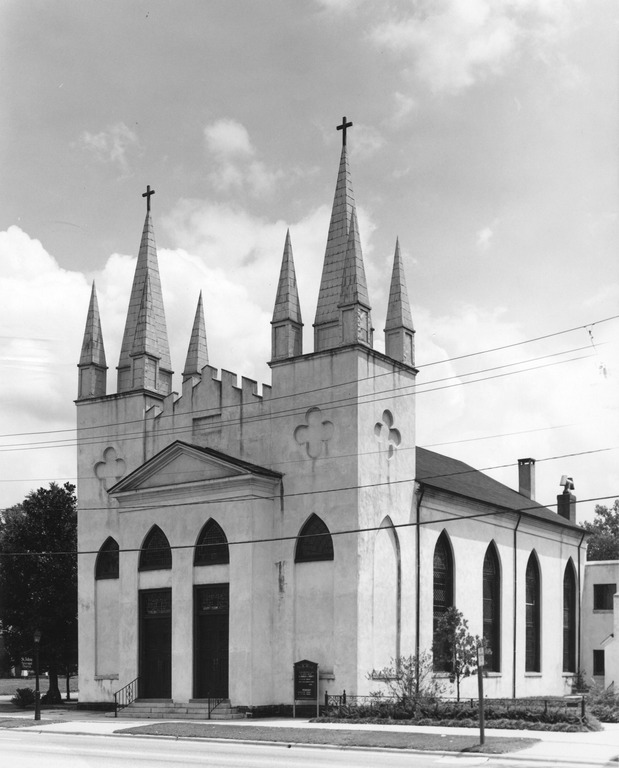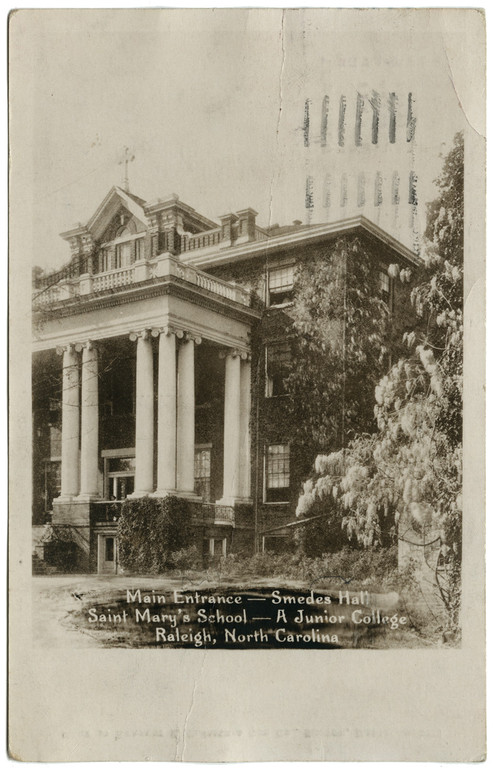Drummond, William S. (fl. 1830s)
Birthplace:
Unknown
Residences:
- Washington, D.C.
- Raleigh, North Carolina
Trades:
- Architect
- Builder
NC Work Locations:
Building Types:
Styles & Forms:
Gothic Revival; Greek Revival
William S. Drummond (fl. 1830s), a builder from Washington, D.C., worked on several notable buildings in Raleigh and Fayetteville during his brief tenure in the state in the 1830s.
Although nothing is yet known of Drummond’s early life and background, in 1830 the United States Census recorded him as a resident of the District of Columbia and head of an eleven-member household, including one male slave. Drummond apparently headed to Fayetteville, North Carolina, in 1831 to find work during a widespread rebuilding after a fire nearly destroyed the town.
Drummond’s only known work in Fayetteville was the rebuilding of St. John’s Episcopal Church, which had burned along with other local edifices. The brick church of simple Gothic Revival design might have been designed by architect William Nichols. Drummond apparently rebuilt it in the old walls, probably reusing the existing footprint and Gothic Revival openings. He created a striking version of the Gothic Revival style with large pointed-arched openings, and twin towers flanking a crenellated pediment, and tall pinnacles and spires accentuating the towers. The building was nearly completed when the Fayetteville Carolina Observer reported on July 3, 1832, “We estimate this edifice as a singularly happy effort . . . . as it introduces into our Southern country a style of architecture to which we have been hitherto unaccustomed. The taste, observable throughout, is of the ancient Gothic, and the execution reflects great credit on the skill of the Architect, Mr. Drummond.”
After completing the church, Drummond returned to Washington, but several leading citizens of Fayetteville—all of them members of St. John’s—lobbied to secure Drummond an appointment as superintendent of construction for the North Carolina State Capitol then underway in Raleigh. In 1831, the State House in Raleigh, as redesigned by William Nichols, had burned. In 1833 the state embarked on rebuilding, this time in stone.
On January 1, 1833, Charles P. Mallett of Fayetteville wrote to Duncan Cameron, chair of the commissioners for the capitol project (and also an Episcopalian), recommending Drummond highly, and another Fayetteville man, William Huske, told Cameron, “I do not know that Mr. Drummond has much Science in his profession, but I question if you will readily find his Superior in practical Knowledge, faithfulness to his employers, [and] skill in managing workmen.” (William Huske to Duncan Cameron, January 1, 1833, Cameron Papers, Southern Historical Collection.)
Drummond was hired as superintendent and moved his family to Raleigh, where he became a well known and respected citizen. Evidently he did as well as predicted. In November, 1833, the building commissioners reported to the General Assembly that “they are much indebted to the zeal, industry, and good management of the Superintendent.” An observer wrote in the Raleigh Register of March 26, 1834, admiring “the regularity and clock-work manner with which Mr. Drummond . . . carries on the work with the numerous workmen under his direction. In 1834, however, conflicts developed for reasons not entirely clear, possibly relating to factions on the commission. In August, the building commissioners hired Thomas Bragg, Sr., a Warrenton builder, as assistant superintendent without Drummond’s knowledge or agreement. Drummond protested and was dismissed by the commissioners. The Raleigh Register reported on August 14, 1834, that the city was in a state of “excitement” over the unexpected dismissal and lauded Drummond’s “skill as an artist, and his energy, system and efficiency as a manager.” William W. Birth, who had been in charge of the masonry department, had resigned because of the dismissal.” Raleigh citizens even organized a mass protest meeting and presented the General Assembly with resolutions testifying to Drummond’s ability and character. A committee appointed to review the matter upheld the right of the commissioners to dismiss Drummond but insisted that he “still deserves the public confidence.”
One of Drummond’s supporters was Duncan Cameron. Immediately after the dismissal, Cameron hired him to supervise construction of his own large, classically detailed Duncan Cameron House on Raleigh’s Hillsborough Street, which cost more than $8,000. Cameron’s papers of the mid-1830s include reference to “Mr. Drummond’s plans,” indicating that he had planned the house as well as managing the project. Among the workmen on the house was the carpenter Jack Dewey whom Cameron had hired from New Bernian Charles Dewey.
In addition, Cameron was probably instrumental in another commission for Drummond. In February, 1835, Cameron, George Mordecai, and the Rev. E. B. Freeman employed Drummond to superintend construction of a large, 3-story, brick building to house an Episcopal boys’ school, located across Hillsborough Street from Cameron’s residence. The building is now the central edifice, called Smedes Hall of St. Mary’s School. Drummond’s agreement stated his immediate duties, “to make out bills for the requisite bricks and lumber; to advertise for the same; to producer lime for the masonry, including water lime for the foundation; to employ hands; to haul rock for the foundation; and to have the well finished immediately.”
Despite these commissions, sometime late in 1835 or early in 1836, Drummond and his family left Raleigh for reasons unknown. His duties as superintendent of Cameron’s building projects were taken over by Thomas A. Waitt. Where Drummond went from Raleigh, and where he spent the remainder of his life remain unknown. According to the United States Census of 1850, a William S. Drummond, architect, aged 63 and a native of Virginia, was residing in Cincinnati, Ohio, in that year, along with his wife, Mary, 64, also of Virginia, and other family members. Whether this was the same man who had worked briefly in North Carolina in the 1830s has not been established.
- Cameron Family Papers, Southern Historical Collection, Wilson Library, University of North Carolina at Chapel Hill, Chapel Hill, North Carolina.
- Episcopal School of North Carolina Papers, North Carolina State Archives, Raleigh, North Carolina.
- “St. John’s Episcopal Church,” National Register of Historic Places nomination (1974).
- Elizabeth C. Waugh, North Carolina’s Capital, Raleigh (1967).
Duncan Cameron House
Contributors:Jack Dewey, carpenter; William Drummond, builder; Samuel Hancock, brickmason; Thomas A. Waitt, builderDates:1835
Location:Raleigh, Wake CountyStreet Address:Hillsborough St., Raleigh, NC
Status:No longer standing
Type:Residential
Images Published In:Elizabeth C. Waugh, North Carolina’s Capital, Raleigh (1967).
Note:The house built in 1835 for Duncan Cameron was remodeled in 1901 for his grandson Bennehan Cameron, who added a large portico and additional rooms. It stood on the south side of Hillsborough Street opposite St. Mary’s School. Portions of its interior woodwork are said to have been reused in a house in Raleigh’s Hayes Barton neighborhood.
North Carolina State Capitol
Contributors:William W. Birth, superindendent, masonry department (1833-1834); Thomas Bragg, Sr., supervisor (1830s); John J. Briggs, carpenter (1830s); Thomas H. Briggs, Sr., carpenter (1830s); Alexander Jackson Davis, architect (1830s); William Drummond, supervisor (1830s); Robert Findlater, stonecutter (1830s); Asa King, carpenter (1830s); William Murdoch, stonecutter (1830s); William Nichols, architect (1830s); William Nichols, Jr., architect (1830s); David Paton, architect and supervisor (1830s); Henry J. Patterson, brickmaker (1830s); William Percival, architect (1858); James Puttick, stonecutter (1830s); William Strickland, consulting architect (1830s); William Stronach, stonecutter (1830s); Town and Davis, architects (1830s); Ithiel Town, architect (1830s)Dates:1833-1840
Location:Raleigh, Wake CountyStreet Address:Union Square, Raleigh, NC
Status:Standing
Type:Public
Images Published In:Catherine W. Bishir, North Carolina Architecture (1990).
Catherine W. Bishir and Michael T. Southern, A Guide to the Historic Architecture of Piedmont North Carolina (2003).
Edward T. Davis and John L. Sanders, A Romantic Architect in Antebellum North Carolina: The Works of Alexander Jackson Davis (2000).Note:Although sometimes credited solely to Town and Davis, the design of the capitol was the result of a sequence of work by William Nichols, Sr. and Jr., Town and Davis, and David Paton, with advice from William Strickland. For a fuller explanation of the chronology and contributions of architects involved in the State Capitol, see Bishir, North Carolina Architecture and other sources cited herein.
Smedes Hall
Contributors:William Drummond, builder (1835-1837); Samuel Hancock, brickmaker (1835-1837); Charles E. Hartge, architect (1909); Thomas A. Waitt, builder (1835-1837)Variant Name(s):Main Building
Dates:1835-1837; 1909 [addition]
Location:Raleigh, Wake CountyStreet Address:Hillsborough St. at St. Mary’s St., St. Mary’s School, Raleigh, NC
Status:Standing
Type:Educational
Images Published In:Linda L. Harris and Mary Ann Lee, An Architectural and Historical Inventory of Raleigh, North Carolina (1978).
Elizabeth C. Waugh, North Carolina’s Capital, Raleigh (1967).Note:The illustration shows Smedes Hall as remodeled by Charles E. Hartge.
St. John's Episcopal Church
Contributors:James Calder, carpenter/joiner (1817-1818); William Drummond, builder (1832)Dates:1817-1818; 1832 [rebuilt]
Location:Fayetteville, Cumberland CountyStreet Address:302 Green St., Fayetteville, NC
Status:Altered
Type:Religious
Images Published In:Catherine W. Bishir and Michael T. Southern, A Guide to the Historic Architecture of Eastern North Carolina (1996).
Note:The brick church was built in 1817-1818, burned in 1831, and was rebuilt on the old walls in 1832. The Gothic Revival window openings probably date from the first period. The original St. John’s was apparently the earliest example of this mode in the state: other early 19th century churches with similar Gothic Revival motifs, dating from the 1820s, include Christ Episcopal Church in New Bern, St. Matthew’s Episcopal Church, St. Luke’s Episcopal Church in Salisbury, and Christ Episcopal Church in Raleigh, some of which have been linked with William Nichols.



